Genetics


Mitochondrial DNA
Indicates
a Single Origin to the Dog in Southern China 5.400 to 16.300 Years Ago
Summary by Dr.
Dominique
de Caprona
© de Caprona
2009
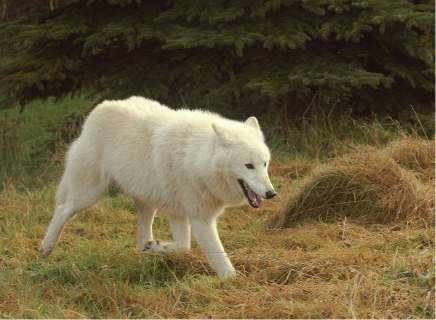 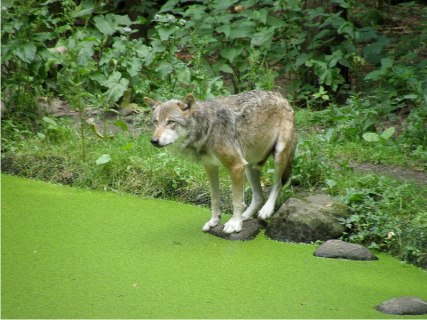
Arctic Wolf (Canada)
(Canis
lupus arctos) © R. Schmode ~
Eurasian
Wolf
(Canis
lupus lupus) © G.Volker
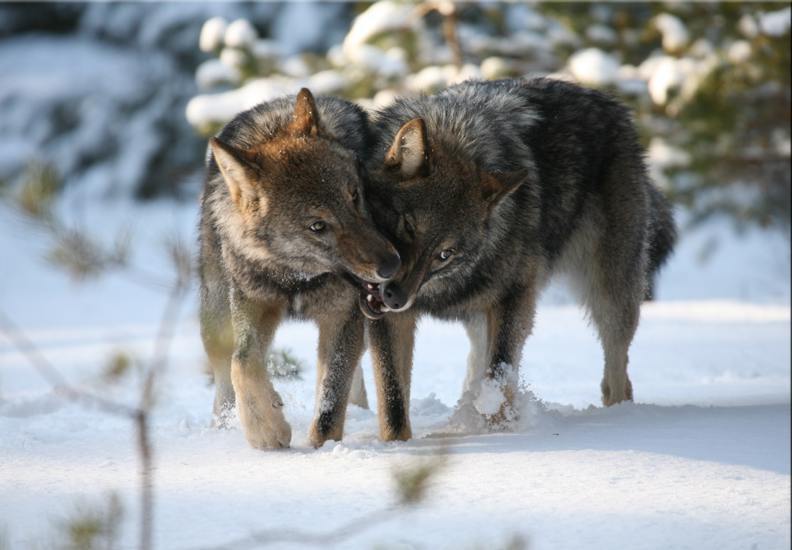 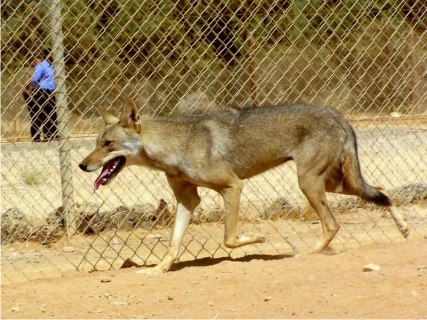
Russian wolves
(Canis lupus
communis) ©
V.Bologov
~ Arabian Wolf (Canis
lupus arabs) critically endangered © S. Rerucha
All
photographs copyrighted to their photographer. Please do not use for
any
purpose without asking.
In their article
entitled
"mtDNA Data indicates a Single Origin for Dogs South of the Yangtze
River, less than 16,300 Years Ago, from Numerous Wolves", Pang et
al.
(2009) analyse the mitochondrial DNA (mtDNA) of a large sample of dogs
to determine when, where and how the wolf was domesticated to become
the
domestic dog.
The study of samples
from
ancient dogs have shown that ancient and modern dogs share the same
mtDNA,
and that American dogs descend from the Old World dogs, hence the focus
of this study on the Old World dogs.
An indepth survey
of the
patterns of geographical diversity for dog mtDNA was carried out by
anlysing
582bp of the Control Region for 1.543 domestic dogs across the Old
World.
Because it had been earlier indicated that the origin of dogs was
somewhere
in East Asia (Savolainen et al 2002), this area was densely
sampled.
This study includes
samples
from Europe (North and South): Britain, Scandinavia, Miscellaneous;
Southwest
Asia:Israel, Iran, Turkey, Miscellanous; Africa: North Africa, Central
Africa, South Africa, Miscellaneous;South East Asia: Thailand, Vietnam,
Cambodia; North China (Heilongjian, Liaoning, Hebei, Shanxi); Central
China
(Shaanxi, Shichuan); South China (Guangdong, Guanhxi, Hunan, Guizhou,
Jiangxi,
Yunnan; Tibet (Quinghai and Nepal) and Hainansanya. Samples were taken
on dogs in rural areas as they were assumed to have little influx of
foreign
dogs or on dogs which belonged to breeds with known historical origins.
Most of the "non-breed" dogs had specialized morphology and were
kept/bred
for specific purposes (guard, pet, herding, meat), they were not
typical
strays.
The wolf samples
analysed
for the 582bp region were from Afghanistan, Canada, China, Mongolia ,
Romania,
Russia, Saudi Arabia, and Yugoslavia.
Based on this
survey, a subsample
of 169 dogs representative across mtDNA diversity were selected for an
analysis of almost the entire mtDNA genome.
The samples
represented
5 of the 6 main phylogenic groups or clades: A,B,C,D,F and E. The study
focuses on the first 3, as the clades D, E,and F are rare,
geographically
restricted and could be derived from post-domestication wolf-dog
hybridisation.
Results
The 2 major dog
clades,
A and B, contained wolf haplotypes.
1) Clade A had 3
haplotypes
from wolves of North China and Mongolia, which differed by 1 or 2
substitutions
from the closest dog haplotypes;
2) In Clade B, 4
wolf haplotypes
were found- 2 from North Chinese and Romanian wolves were identical to
dog haplotypes, and 2 from Afghani and Yugoslavian wolves differed by 2
substitutions from the closest dog haplotypes.
The study of wolves
haplotypes
remains incomplete because of the extinction of wolves in large parts
of
Europe and southern Asia and for this reason cannot give any tangible
insight
as to the diversity of wolf haplotypes at the time of domestication.
Therefore the
authors focused
on comparing the distribution of genetic diversity among the dogs
themselves
across the world to determine the place and time of the domestication
of
the wolf.

Tamed Mongolian wolf
pup
(Canis lupus chanco)
Bayan-Olgii, Kazakh
Golden
Eagle Festival, West Mongolia
© Alexander
Choi Jackson
2006
The authors
find that
the Old World dogs share a homogenous gene pool:
1) Clades
A, B, and C were found in every population,
from 97.4%-100% of all dogs.
2) The
proportions of individuals with these haplotypes was similar across the
Old World.
3) 14
of the haplotypes
(9 in clade A, 2 in clade B, 3 in clade C) were termed Universal
Types
or "UTs"
4)
The UTs were very frequent in the western part of the Old World (West
of
Ural and Himalayas): 81.5% of dogs in Europe and Southwest Asia had a
UT
which is the same as a dog in Asia.
5)
The UTs were much fewer in East Asia - 54.2% of the dogs there have
them,
and in the extreme Southeastern part of China (South of the Yangtze
River)-
40.8% of the dogs have UTs with a range from 18.4% to 54.7% among the
provinces.
6) Interestingly,
in the West, all other haplotypes apart from the UTs differ by a single
mutation from a UT. 98.7% of European dogs and 94.6% of Southwest Asian
dogs either had a UT or a UT derived haplotype (UTd). This means that
almost
all the dogs in the West had a haplotype traced back to a haplotype
also
found in East Asia
7)
In contrast, only 69.2% of East Asian dogs and 53.0% of dogs South of
the
Yangzte river had UTds.
8)
The genetic diversity follows a gradient, from maximum levels at one
end
of the continent South of the Yangtze River, decreasing through East
Asia
and Eurasia to reach the lowest levels in Europe at the other end of
the
continent. This
affects
Clade A in particular, Western populations lacking several mostly
identical parts of Clade A, the populations having an almost complete
representation
across clade A being those South of the Yantze River.
9) The
Western dogs have a haplotype pool which consists almost exclusively of
14 UTs and surrounding haplotypes. East Asian population particularly
in
Southern China have a large proportion of dogs with unique haplotypes a
large distance away from the UTs, therefore also from the haplotypes
found
in the West.
10) The
complete mtDNA genome analysis shows that clades A, B and C consist of
several subgroups. Clade A has 6 major subclades, Clade B and C have 2
subclades each, for a total of 10 subclades or haplogroups.
The complete set
of 10
subclades is found only in Southern Eastern China, 7 are found in
Central
China, 5 in Northern China/India/SWAsia, and only 4 in Europe. 5 of the
6 Clade A subclades were found only in East Asia. In Southern China, no
province had all 10 subclades, but in Yunnan, Southeast Asia and
Guizhou,
9,9, and 8 of these subclades were found. The smallest region
containing
all 10 subclades is in the Southwest area
South of the Yangtze River.
11) The
substitution rate for the mtDNA data was calculated to estimate the age
of the phylognetic groups. The fossil record is incomplete and the
separation
time for dog/wolf and coyote cannot be calibrated exactly. The data
indicate that clades A,B and C spread simultaneously across the Old
world
5.400 to 16.300 years ago.
12)
The minimum number of lineages was estimated for the whole mtDNA genome
data which existed at the time of the spread of the dogs across the Old
World. Haplotypes separated by more than 12 substitutions from each
other
should have originated from different founders at the time of the
spread. In
counting such haplotypes, the authors find a minimum of 51 different
female
wolf lineages behind today's dogs' haplotypes. This estimate is
conservative
and the authors assume that several hundred female wolves were
domesticated.
They base their assumption on the fact that
A. some
haplotypes
differing by less than 12 substitutions could be from different female
wolf founders
B. some
lineages
may be present that are not detected in this data set
C. some
lineages
may have become extinct since the domestication of the wolf
D. some
founder female
wolves may have had the same haplotype
13)
The exact area South of the Yangtze where the domestication of the dog
may have taken place is not clear. The full representation of all 10
subclades
is found in a region which includes Yunnan, and South East Asia.
Guizhou
has more haplotypes than Yunnan and only one subclade less.
Conclusions
1) The
simplest explanation for the geographical distribution of the 10
subclades
of clades A, B and C is that they had a single origin within the area
close
to the South of the Yangtze river and South Eastern Asia. From there a
subset of the original gene pool spread to the rest of the world.
The similar
proportion
of these 3 clades across populations of the old World indicate that
these
populations originate from a founder population with a similar
proportion
of the 3 clades. Had the domestcation of the dogs happened
independently
in various areas, one would expect a large proportion of regionally
unique
haplotypes and varying proportions of the clades would be expected.
Populations genetic
simulations
showed that multiple origins in time would have required extreme
migration
rates and thorough mixing of the populations to end up with the
observed
proportions of the clades, an unlikely event. The only scenario which
includes
moderate migration is that of a single origin in time and space for the
3 clades.
2) It
is not possible to date the origins of dogs from these data, but the
date
of the spread from the center of origin can be estimated. If the dog
populations
spread shortly after the domestication of wolves, the genetic data
indicate
that dogs originated approximately 5.400 to 16.300 years ago.
Because one
substitution
in the mtDNA genome corresponds to 3.200-9.600 years, the sharing of
subclades
and UTs across Eurasia is not caused by recent mixing of populations
but
results from ancient events.
3) These
results show for the first time reasonable estimates for the time of
origin
of dogs and the number of female founder wolves. They dismiss the
assertion
by Vila et al 1997 that mtDNA indicate an origin of dogs much earlier
than
10.000 to 15.000 years ago.
4)
The European dogs lack 6 of the 10 subclades. They have a special
history
compared to other dog populations in that they have specialized in a
very
large number of dog breeds. For this reason one could think that the
low
genetic diversitry of European dog breeds results from severe
bottlenecks
during the development of the many different breeds. However the gene
pool
is almost identical to that of the dogs from South West Asia. Therefore
the 6 subclades must have been missing already before the development
of
the many different breeds in Europe. In spite of the largest
morphological
variation in all of their many breeds, the European dogs have the
lowest
genetic variation, and this fact places them at the periphery of the
Eurasian
dog populations, and does not reflect modern breeding history.
5)
The analysis of the whole mtDNA genome, as opposed to the mtDNA bp
analysis,
brings the necessary finer resolution needed to time the dog
domestication
more appropriately in good agreement with archaelogical finds.
6)
It is possible that the domestication of wolves was a widespread
practice
which took place in various regions South of the Yangtze River. The
North
Chinese dogs' genetic diversity is very low and comparable to the
European
dogs with only 5 subclades and 89.8% UTds. The wolf was present in
South
Eastern China until the 1950s although it is now extinct there.
Interestingly
Olsen and Olsen (1977) found that a morphological feature typical of
the
dog's jaw is found also in Chinese wolves ( the turned-back apex of the
coronoid process of the ascending ramus). Added to the relatively small
size of the Chinese wolf, these 2 authors had concluded that the
Chinese
wolf was a likely ancestor of the dog.
7)
This study focuses only on the mtDNA of today's dogs and therefore only
on the domestication of the female wolves which were ancestral to
today's
dogs.
If there was any
taming
or domestication of wolves or other canids which are not ancestors of
today's
dogs, this study does not reveal it.
These results
give for the
first time some indication as to which human culture may have tamed the
wolves. The time and place of the domestication of the wolves coincides
with the transition from hunting to farming and the emergence of rice
culture. This
study shows that a large number of wolves were domesticated suggesting
that the domestication was not a chance/isolated event but probably a
widepread
custom - it also shows that the domestication of wolves happened only
once.
The authors
hypothesize
that the wolf was first tamed as a source of food, as dogs have been
eaten
on a large scale in Southern East Asia until today. They suggest that
the
use of dogs for herding, hunting or companionship was perhaps the
result
of selection by European non-dog eating peoples.
The authors state
that more
thorough studies in South East Asia of archaelogical canid remains, and
of genetics of modern and ancient canid samples should help to
ascertain
the validity of this hypothesis. The authors also stress that a similar
study on the male lineages (Y chromosome) would complement this study
of
the mitochondrial DNA of female wolf and dog lineages (mtDNA being only
inherited through female lines)
Acknowledgments
I thank
Peter Savolainen and Arman Ardalan for their positive comments,
Vladimir
Bologov for the Russian wolves picture, Simon Rerucha for the Arabian
wolf
picture, Alexander Choi Jackson for his picture of the
Mongolian
Wolf and boy, and Philippe Touret for providing
the
invaluable pictures of Chinese dogs and the information pertaining to
them.
References
Olsen SJ,
Olsen JW (1977): "The
Chinese Wolf, Ancestor of New World Dogs", Nature 197: 533-535
Pang JF,
Kluetsch C, Zou
XJ, Zhang AB, Luo LY, Angleby H, Ardalan A, Ekström C,
Sköllermo
A, Lundeberg J, Matsumura S, Leitner T, Zhang YP, Savolainen P.(2009):"MtDNA
Data
Indicates
a
Single Origin for Dogs South of Yangtze River, less than
16,300 Years Ago, from Numerous Wolves." Mol Biol Evol. 2009
Epub.
Sep 1.
Savolainen P,
Zhang Y,
Luo J, Lundeberg J, Leitner T (2002): "Genetic evidence for an
East
Asian Origin of Domestic Dogs." Science 298:1610–1613.
Examples of
modern Chinese
dogs, photographed in the Guangxi and Guizhou areas, South of the
Yangtze
River in August of 2009
(none of these dogs
were
strays, they all belonged to a specific house and someone who took care
of them; the information in the photos' captions is given by Philippe
Touret)
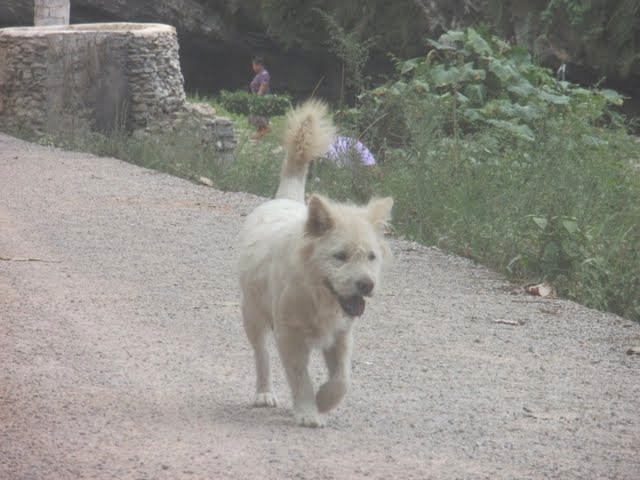 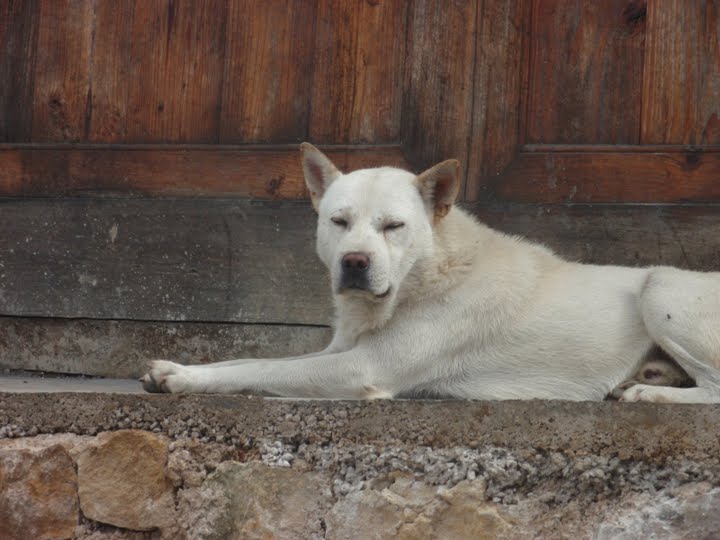
© Philippe
Touret 2009
Left: Bitch
"Xiasi
Quan" in the small horned Miao*
village
of Boji. The breed, which is named after the village of Xiasi,
prefecture of
Kaiili, is
now accepted in most Chinese dog shows.
Right: dog
from the
Matang village of the Gejia people (Guizhou). All the dogs of this area
were taller, more powerful and long-legged and of that off-white
color.
In a collection of
thousands
of pictures of this region's dogs, the first time these dogs are
documented.
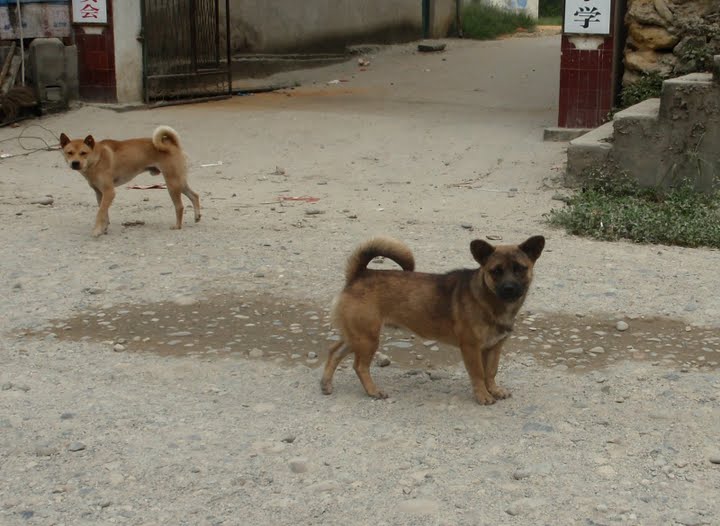 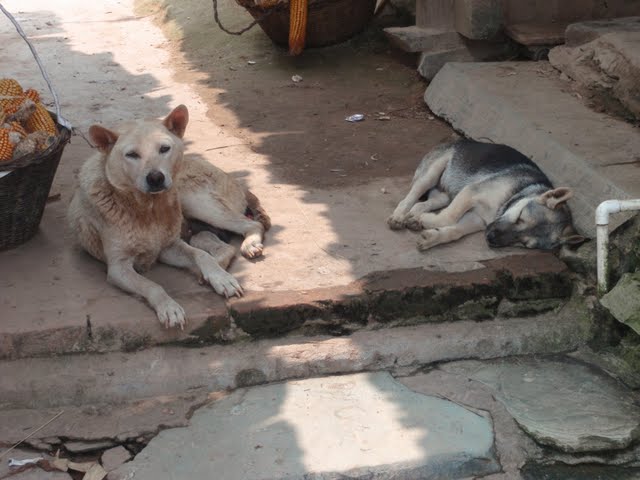
© Philippe
Touret 2009
Left: photograph
taken
in
the
small town of Yangxi (Guangxi)
Front :a "Pig-Dog"
of the
minority Dong. Its name relates to the fact that once it has been
fattened,
slaughtered and skinned,
this dog looks like
a piglet,
its body being covered with a skin of fat.
Back: a typical
hunting
dog of the Guangxi region. The curled tail is not the tail carriage
liked
by the local hunters
who prefer a
straight tail
carried high, which enables them to see the dog in high grass.
Right: dogs
of Biasha
(Guizhou), village inhabited by black Miaos*.
The local dogs
represent
an intermediate type between the dog types of Guangxi and Guizhou
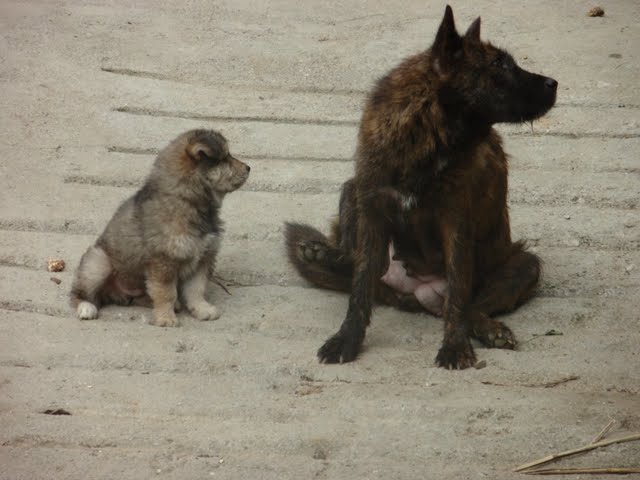 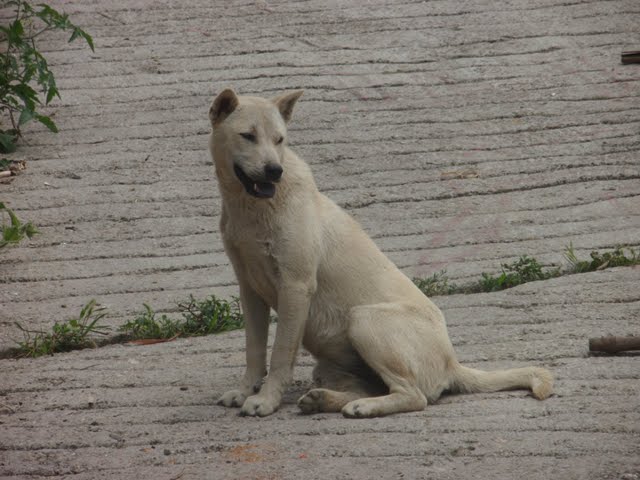
© Philippe
Touret 2009
Left: dogs
of Gaoyao
(Guizhou), only village during that trip where brindled dogs were
seen.
The puppy resembles
a traditional
Chow-Chow, his mother has the characteristics of an official Xiasi
Quan,
except her color.
The white color for
this
breed is imposed by the standard but other coat colors can be found (
black,
fawn, slate blue, brindle)
Right: bitch
photographed
in small horned Miao* village of
Qingman
(Guizhou). Type close to the breeds hunting boar in neighboring Guangxi.
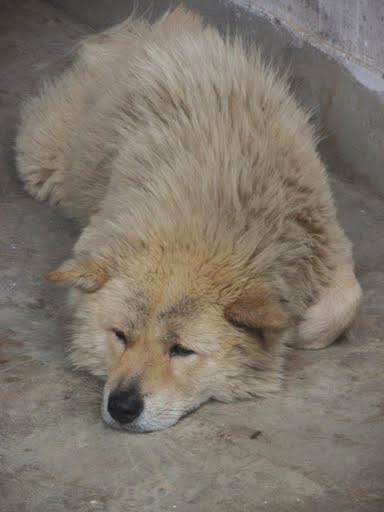 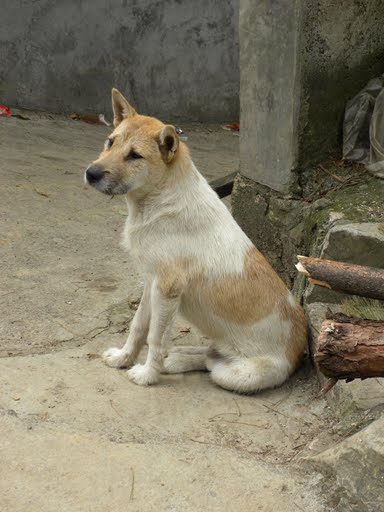
© Philippe
Touret 2009 ~
© Jean-Maurice Touret 2009
Left: Photograph
taken
in
Dingwei
(Guizhou). Dog of original Chow-Chow type, roots of this
breed to be found towards Guangdong
Right: photograph
taken
in
the
Miao village of Gaoyao (Guizhou).
Dog close to the
Xiasi Quan
type, slightly wire haired,
particolored coat
unusual
for the region where solid colors are the absolute majority.
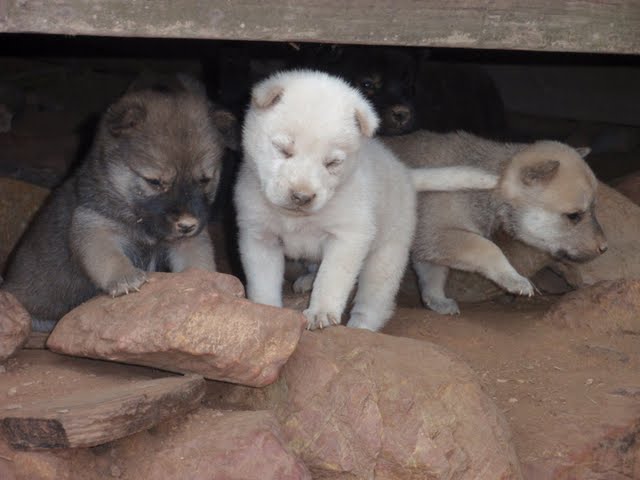
Puppies photographed
in
black Miao* village of Biasha
(Guizhou)
© Philippe Touret 2009
ABOUT
THE
AUTHOR
Author's notes:
*The
Miaos are a group of linguistically related people in Southwest China.
They are referred to in Chinese as "small horned" or "long-horned"
Miaos
depending on the length of the horns of the headpiece they wear, or
black,
white, red, striped, small flowery, big flowery, green, blue Miaos
depending
on the most characteristic color of the women's clothes.
|


